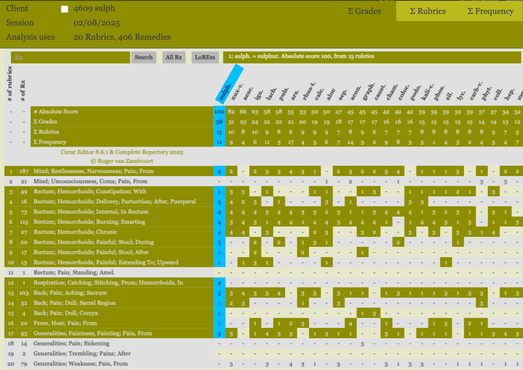
CLINICAL CASES, ILLUSTRATING THE DIFFERENCE BETWEEN TRUE AND DELUSIVE HOMEOPATHY.
By E. W. BERRIDGE, M. D., Homoeopathic World 1883 vol 18, p 76
(4) Sulphur in Hemorrhoids.— November 23rd, 1871, Mr. D., æt. 30, consulted me. She had been subject to piles for four or five years; two years ago they were bad for three days. Was confined seven weeks ago, and piles have been worse since; very bad for the last month. At first they were external, but now internal. During and after stool this last for six or seven hours after stool. Stool once in from two to four days, otherwise natural. The pain makes her feel faint, trembling, sick, inclined to move about, hot, and as if she would lose her senses; the pain at anus is better when standing than when lying. Has taken, by the advice of a professed Homoepathic physician Acon., Nux 3, and Sulph. 3, but without relief.
Diagnosis of the remedy.—Bönninghausen's Repertory gives "Shooting in rectum affecting the breath, Sulph." This I took as the keynote or starting-point, and finding that it corresponded fairly with the other symptoms of the case, I gave her one dose of CM (Fincke). Nov. 29th. Piles gone; pain much better, lasting only two hours after stool; still costive; pain was bad yesterday, but better all the other days; much less weakness, trembling, heat, and feeling of losing senses; shooting does not catch the breath so much.
April 10th, 1872.— Reported that she perfectly recovered within a week, and has remained so. In 1874 1 saw her again, and she had had no return of the symptoms, though she had had another child.
Comments.—(L) The value of keynotes or characteristics is here shown. A keynote is not a symptom on which we prescribe without reference to the rest; but it is a symptom so characteristic of the remedy that we almost always find the remaining symptoms of the case covered by it; hence a knowledge of keynotes saves much trouble in the selection. If, however, we do not find the remaining symptoms covered by the remedy which has the supposed keynote, we must then decide which group is the most important. A characteristic sometimes consists not of a single symptom, but of a group of symptoms.
(2) The superiority of the high over the low potencies is also shown, as Sulph. CM. cured after Sulph. 3 had failed. The case also shows that Fincke's fluxion potencies are not low potencies, as some have ignorantly or maliciously asserted; else how could they cure after bona-fide low potencies had failed ?
(3) On the sixth day of the action of the dose the pains, which had been relieved, became severe again. This form of aggravation almost always occurs from time to time in the treatment of a chronic case; the remedy should never be changed, nor the dose repeated, under these circumstances, unless the aggravation continues, when the case must be studied afresh, especial search being made for new symptoms. Usually a new medicine is indicated by these new symptoms, but it sometimes happens that the same remedy is again indicated. In the latter event it usually acts better when repeated in a different potency, or in a different degree of repetition.
48, Sussex Gardens, Hyde Park, W.


Add comment
Comments